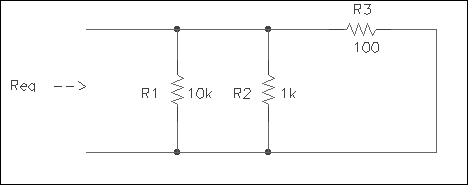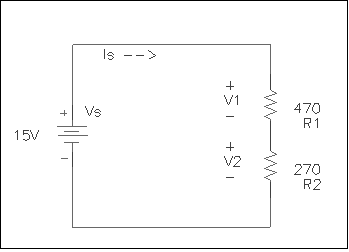EE101 - Lab 2: Resistive Circuits
ALL PRELABS ARE TO BE COMPLETED ON SEPARATE PAPER AND TURNED
IN AT THE BEGINNING OF THE LAB PERIOD (MAKE A COPY TO USE DURING THE LAB). ALL LAB EXERCISES MUST BE
COMPLETED IN A COMP BOOK, USING BLUE OR BLACK INK. NO ANSWERS
ARE COMPLETE WITHOUT THE UNITS!!
Deciphering the Resistor Color --- Note: carbon
composition resistors will be used
Resistors are labeled with colored stripes. Each color corresponds to a digit between 0 and 9 as listed in the table below. The resistor value is made up of two significant digits (the first two stripes) times ten to the power of the third stripe. The fourth stripe designates the tolerance as a percentage (the actual value could vary from the labeled value by up to that amount). The decimal point comes after the second digit. The first digit will never be a zero unless the resistor value is a single digit number (1 Ω thru 9 Ω). Be careful distinguishing colors, different manufacturers use slightly different colors so the difference between certain colors (especially red and orange) can be difficlut to tell apart. When in doubt, use a meter and measure it.
You can use the following standard form: (first stripe) (second stripe) . x 10 ^ (third stripe) +/- (fourth stripe) %
For example, a 1 KΩ resistor should look like this: 10 x 10^2 which corresponds to 10. (brown black) times ten to the 2 (red) or "brown-black-red."
If the last stripe is gold, then the tolerance is 5% which means that the actual value will be within 5% of 1 kΩ. Therefore the actual value should be between 950 Ω and 1050 Ω

| Color |
Value |
Multiplier |
Tolerance |
| Black |
0 |
1 |
|
| Brown |
1 |
10 |
|
| Red |
2 |
100 |
2% |
| Orange |
3 |
1,000 |
|
| Yellow |
4 |
10,000 |
|
| Green |
5 |
100,000 |
|
| Blue |
6 |
1,000,000 |
|
| Violet |
7 |
10,000,000 |
|
| Gray |
8 |
100,000,000 |
|
| White |
9 |
1,000,000,000 |
|
| Gold |
|
|
5% |
| Silver |
|
|
10% |
Prelab Exercises
-
Using the resistor color code chart above, list the three colors (in proper
order) that would be found on the following resistors:
-
23,000 ohms
-
670 ohms
-
1,000 ohms
-
The resistors in the following circuit are said to be in series.
That is, they are connected one after another to each other, with no other
circuit elements connected where each is joined. For series resistors,
the equivalent resistance, Req, is obtained by simply adding the resistance
values (R1 + R2 + ...). An equivalent circuit for the one in the
figure would simply be one resistor with the value that you calculated
for it. Determine the equivalent resistance, Req, for
this network and draw an equivalent circuit.

Note that resistor value units in these diagrams are specified by k for kilo-ohms,
and if there is no k or other designator then it is plain ohms
-
The resistors in the circuit below are said to be connected in parallel
with
each other. Parallel circuit elements are elements which are joined
to each other at both terminals. The equivalent resistance for parallel
resistors is calculated by adding the reciprocals of each resistor, and
then taking the reciprocal of that sum. Determine the equivalent
resistance, Req, for this network.

-
Using your knowledge of Kirchoff's Voltage Law and Ohm's Law, calculate
the values for Ia and Ib. With this information
and Kirchoff's Current Law, determine the value for Is.

-
Draw an equivalent circuit for the network given below by calculating an
equivalent resistance for the two resistors. Then, Determine the
value of Is by using what you know about KVL, KCL, and Ohm's Law.
Once you have determined the value for Is, refer to the original schematic
and calculate the values for V1 and V2.

(end of pre-lab)
EE 101 Lab Exercise 2: Resistive Circuits
(The exercises outlined below should be included in the Data section
of your lab write-up.)
-
Take the resistors out of their bag. Make sure there are 8 of them. Make
a chart with headings like the one below. List each resistor by its color
bands (see column "Resistor Color Bands" below). Using the color code scheme
given on the chart, determine the values for each resistor and write these
in the column under "Value". If you are color-blind, now is
a good time to mention this! When you have done this for
each resistor, measure the resistor values with a multimeter (set to ohms).
Write this value in the "Measured Value" column. When you are measuring
resistances, be sure not to grab the leads with your hands, because you
will, in effect, be including your own resistance (in parallel) to that
resistor (and this may affect the answer you get). All the resistors in
this lab have a tolerance of 5% (as indicated by the gold band on the end).
Indicate whether or not the resistors are within tolerance in the last
column. You will be using these again later in this lab, so be sure to keep them organized. When you are finished with the lab, put the resistors back in their bag.
| Color Bands |
Labeled Value |
Measured Value |
Percent Difference |
Within Tolerance |
| br-blk-r-(gold) |
1 KΩ |
1.04 KΩ |
4.0 % |
yes |
Exercises 2 - 5 require you to build circuits on a protoboard. For
all of these circuits, proper breadboarding technique will be expected.
This includes using the built-in runners on the breadboards when applicable,
using wire cut to proper lengths, and using a proper amount of breadboard
space. In short, the circuits you build should be "readable." Any circuit
that does not demonstrate proper breadboarding technique will have to be
rewired.
-
Using resistors and wire, build the circuit from Exercise 2 in the pre-lab.
Power does not need to be applied to this circuit. Use the multimeter
to measure the equivalent resistance (Req) of the circuit.
What value do you measure, and how does this compare to the value you calculated
in the prelab? (Perform a percent difference between the measured value and
the expected value of the equivalent resistance.) The equivalent
resistance value you measured here was probably not exactly what you had
calculated in the prelab. What reasons can you think of to account
for this difference?

-
Follow all the instructions from number 2 above for Exercise 3 in the pre-lab.
-
Build the circuit from Exercise 4 in the pre-lab. Ask one of the lab
assistants to check your circuit before applying power to it.
-
Measuring current using Ohm's Law: Using a volt meter,
determine the value for Ia by first measuring the voltage
drop across the resistor, and then, solve for the current using Ohm's Law.
Measure the voltage drop first with the meter probes one way (red/black),
then the other (black/red). What affect, if any, does switching the probes
have on your measured voltage value? Write down your answer for Ia
(positive answer). In the same way, measure and record the value of Ib.
Perform a percent difference between these current values and the ones
you calculated in the prelab exercise for this circuit.
-
Now, measure Ia and Ib directly by using the
multimeter set to measure current by "breaking" each branch of the
circuit - remember, do not attach the leads in parallel with the resistor! Be sure you understand how to do this, if you are not sure, ask before trying something because you can damage the meter by measuring current incorrectly. Record the values. Perform a percent difference between
these current values and the ones you calculated in the prelab exercise
for this circuit.
-
Determine the source current (Is) by "breaking" the circuit
and using a current meter. Is this value for Is equal to
the sum of what you measured for Ia and Ib?
-
With the help of a multimeter, set the protoboard's adjustable source voltage
to as close to 15V as you can make it. This will be Vs for
the circuit in Exercise 5 of the prelab. Record the actual value
you set for
Vs. Build the circuit from Exercise 5, and as
always, ask one of the lab assistants to look over your circuit before
applying power to it. With the multimeter, measure V1
and V2. Perform a percent difference between your measured
voltages for V1 and V2 and those values that
you calculated in the prelab. Do these two (measured) values add
up to equal the value that you set for your source voltage?
Questions:
(These questions and their answers should be included in the Questions
section of your lab write-up).
-
In lab exercises 2 and 3, the equivalent resistance values that you measured
were probably not exactly what you had calculated in the prelab.
What reasons can you think of to account for these differences?
-
In exercise 4, you were asked to measure the voltage across the resistor
with the multimeter probes one way (red first, then black, or "+" then
"-"), and then the other way ("-", then "+"). The sign of your measured
voltages should have changed when you did this. What convention
mentioned during lecture was demonstrated here?
-
Also in exercise 4, you measured values for the two branch currents
(Ia and Ib) along with the source current (Is).
What law was demonstrated when you verified that the branch currents summed
to equal the source current?
-
In exercise 5, you were asked to note if V1and V2
summed to equal Vs. What law was demonstrated here?
(Be sure to include a brief synopsis of this lab in the Summary section
of your lab write-up).
January 2001
Copyright 2001, New Mexico Tech





